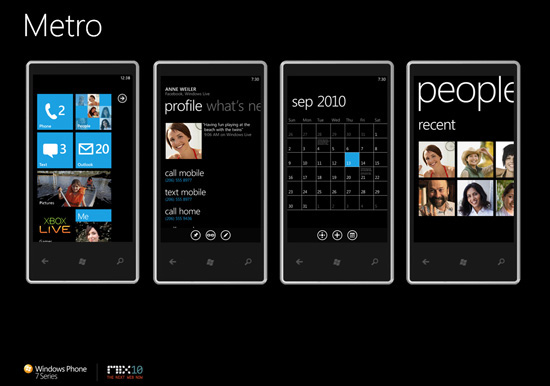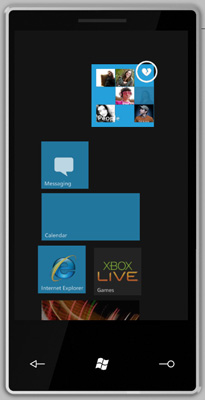Windows Phone 7: The AnandTech Guide
by Brian Klug on March 21, 2010 12:00 AM EST- Posted in
- Smartphones
- Windows Phone 7
- Mobile
Recapitulation
Microsoft MIX 2010 has drawn to a close, and with it comes our concluding wrap-up of everything that there is to discuss about Windows Phone 7 Series (henceforth WP7S).
Let's start at the beginning - WP7S does away completely with everything Windows Mobile. That means Windows Mobile applications won't run on WP7S, hardware running Windows Mobile won't run WP7S (including HTC's HD2), and Windows Mobile is no longer being actively developed. Existing hardware will get support for corporate clients, and the developer tools will remain, but they won't be actively developed. Consider Windows Mobile officially banished from the Microsoft kingdom, and you get the perspective. To give you an example of just how banished Windows Mobile is, there was virtually no discussion of porting applications from Windows Mobile to WP7S - this is a completely different platform. Microsoft wants developers to forget about Windows Mobile and immediately start thinking WP7S. The sense of urgency is because Windows Phone 7 Series will ship before the end of the year ("Holiday 2010").
Microsoft has tossed out the Windows CE-derived, aging UI of Windows Mobile. In its place, it has created a typographically-driven "user experience" that takes taken nods from Windows Media Center, the Xbox Dashboard, Zune HD interface, and urban signage. It calls this style "metro."

Metro - "It's about content and typography"
Instead of standalone application icons, WP7S uses "tiles." In practice, these are almost the same thing, except developers can both change the icon and dominant text to notify the user at-a-glance of status changes or updates. Tiles are supposed to be animated and dynamic. Tiles then launch into sessions and pages. The user interface bleeds off the sides - Microsoft wants people to navigate right to left across a page, teasing the user with elements from neighboring sections. Tiles are rearranged on start page much the same way they are on iPhone OS - pressing and holding levitates a tile, from which point you can either delete the tile (by clicking a broken heart) or drag and rearrange.

Tiles have feelings too...
Optionally, you can launch applications from a comprehensive list view as well.
The UI can be loosely customized, but right now it boils down to four different "accent" colors - which are the tile and UI highlighting colors - and "light" or "dark" for an either black text on white, or white text on black experience. Part of this customization is to leverage the battery-saving properties of AMOLED screens which consume far less power with white text on a black background.
Next are what Microsoft is calling "hubs." These are usually double-wide tiles, and serve as sort of an application for organizing your applications. For example, instead of having a lot of standalone applications which edit or modify photos spread throughout the launcher, you can optionally also launch them through the photo hub right alongside where you view pictures. Another example would be the way apps like Last.fm can themselves be launched from within the music + video hub, right alongside your Zune collection and play history. So far, there are hubs for people, pictures, office, music + video (Zune), marketplace, and games.

Note "apps" to the right. Microsoft is hip.
What each of the hubs do is pretty self explanatory. People is where you'll find all your exchange and local contacts, Pictures is for albums and slideshows, Office includes Excel, Word, and OneNote documents, and Music + Video bundles Zune music and videos alongside other media on WP7S. Marketplace is WP7S' take on an application store, and Games has tight integration with Microsoft's cloud services, including Xbox LIVE. More on that later.
















55 Comments
View All Comments
PsychoPif - Monday, March 22, 2010 - link
MS will push the upgrades, not the carriers.shady28 - Sunday, March 21, 2010 - link
Wow, you know there are (were) really only 5 platforms in the smartphone space - Windows Mobile, Palm WebOS, Blackberry RIM, iPhone, and Android. All of them were unique in their own way and had their own 'fanbase'.
Now MS has removed their uniqueness. Rather than improving on WinMo, they've decided to try to go head to head against the iPhone by attempting to match up against the iPhone's strengths (ie, interface, ease of use, MP3 player integration, app store, etc).
Naturally they've failed to best the iPhone in those categories by a long shot. Instead they essentially have made a device that is 'less than an iPhone' rather than a better WinMO device. I'd say this is the move that will kill off WinMo.
Johnmcl7 - Sunday, March 21, 2010 - link
Whatever you think of S60 and Maemo, Nokia still have a large share of the smartphone marketAzsen - Sunday, March 21, 2010 - link
Does Microsoft seriously think that home screen user interface looks good? It looks flippen hideous!! Give me iPhone UI any day.straubs - Monday, March 22, 2010 - link
No kiddding! Look at the Pre and then look at WP7S and tell me that doesn't look like something someone drew up in their basement in 1978. The single color and square corners are awful, not too mention huge amounts of wasted space everywhere.melgross - Sunday, March 21, 2010 - link
One thing that wasn't clear to me is whether or not music and books will be available without going through the marketplace. Apps can only be gotten there, so ok. The same thing is true for my iPhone. But I can get books, video and music onto the phone that weren't bought through the App Store or iTunes. Would that be possible here as well?The article didn't touch on that from what I saw. Anyone know?
nerdtalker - Sunday, March 21, 2010 - link
I touched on it, but only very briefly ;) partly because it's, you guessed it, not totally finalized. Microsoft wants everything to go through the marketplace, so that means yes, music, videos, and games are all marketplace purchases.A lot of developers were asking whether there was any API for them to do in-application commerce, and the answer was that this was still being worked on. Think the same way you can buy additional levels or addons in-game on the iPhone that are billed through the App Store. It isn't present in the builds of WP7S - yet.
It's another one of those things they haven't fully fleshed out yet, and haven't decided whether they can finish in time for release.
I didn't hear any mention of books at all, that's a great point. I'm not sure whether there's any strategy there.
Cheers,
Brian
CSMR - Sunday, March 21, 2010 - link
It looks like there is some complex sync process to transfer special types of file.You can't just plug in the phone, open it up as a storage device and drag files to and fro, as you can now.
Instead you probably need to install special sync software.
My advice: avoid and get a phone that is recognized as a storage device and has a usable file system.
MGSsancho - Monday, March 22, 2010 - link
Maybe it behaves like my ZuneHD. i just put music and audio books into my music folder and videos into my video folder. then it shows up in the Zune app. if i want to auto sync pics, vids, podcats and music it can or I can manually drag stuff the the ZuneHD device icon. oh you can either encode videos yourself or the app will do it for youMrPIppy - Sunday, March 21, 2010 - link
iPhone apps are sandboxed, but they are *not* managed code. Objective-C is compiled into ARM binaries, and garbage collection is not available on iPhone.